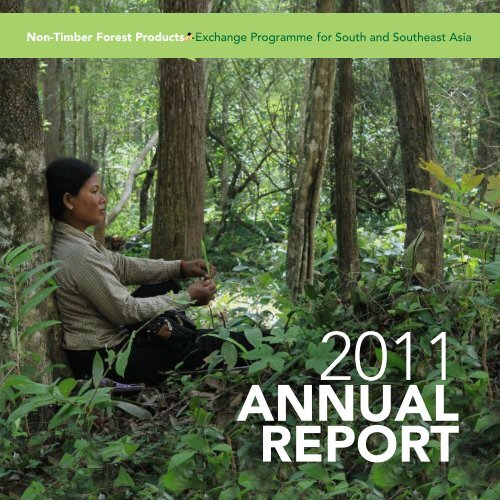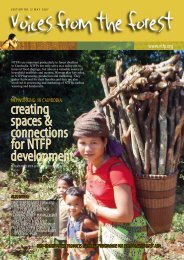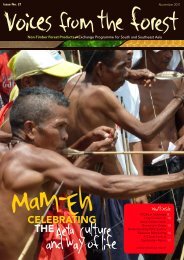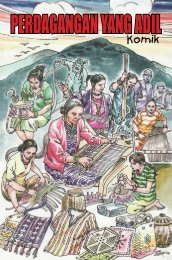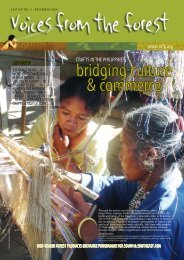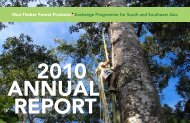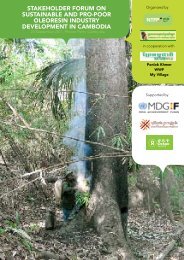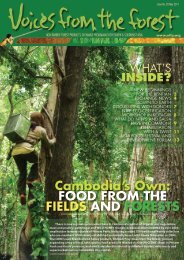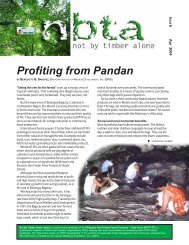Download PDF - Non-Timber Forest Products Exchange Programme
Download PDF - Non-Timber Forest Products Exchange Programme
Download PDF - Non-Timber Forest Products Exchange Programme
- No tags were found...
Create successful ePaper yourself
Turn your PDF publications into a flip-book with our unique Google optimized e-Paper software.
2011ANNUALREPORT
ACRONYMSADSDPPASEANASFCCASFNCBDCBHECBOCMCCCNWGCSODENREUFPRDIFRAFSCGPSHCVFICCAICIMODILOIPsIUCN-NLNCIPNGONTFPNTFP-EPNTFP-TFPESAPNRPSPRMRecoftcREDD+SDCSFCSOM-AMAFSSNCWWFAncestral Domain Sustainable Development and Protection Plan (Philippines)Association of South East Asian NationsASEAN-Swiss Partnership on Social <strong>Forest</strong>ry and Climate ChangeASEAN Social <strong>Forest</strong>ry NetworkCenter for Biodiversity and Development (Vietnam)Community-Based Honey Enterprises (Cambodia)Community-Based OrganizationCustomMade Crafts Centre (Philippines)Cambodia NTFP Working GroupCivil Society OrganizationDepartment of Environment and Natural Resources (Philippines)European Union<strong>Forest</strong> <strong>Products</strong> Research and Development Institute (Philippines)<strong>Forest</strong> Rights Act (India)<strong>Forest</strong> Stewardship CouncilGlobal Positioning SystemHigh Conservation Value <strong>Forest</strong>Indigenous Communities Conserved AreasInternational Center for Integrated Mountain DevelopmentInternational Labour OrganizationIndigenous PeopleInternational Union for Conservation of Nature of the NetherlandsNational Commission on Indigenous Peoples (Philippines)<strong>Non</strong>-Government Organization<strong>Non</strong>-<strong>Timber</strong> <strong>Forest</strong> <strong>Products</strong><strong>Non</strong>-<strong>Timber</strong> <strong>Forest</strong> <strong>Products</strong>-<strong>Exchange</strong> <strong>Programme</strong><strong>Non</strong>-<strong>Timber</strong> <strong>Forest</strong> <strong>Products</strong>-Task Force (Philippines)Panchayat (Extension to Scheduled Areas) Act (India)Philippine National REDD+ StrategyParticipatory Resource MonitoringCenter for People and <strong>Forest</strong>sReducing Emissions from Deforestation and <strong>Forest</strong> DegradationSwiss Agency for Development and CooperationSarawak <strong>Forest</strong>ry CorporationSenior Officials Meeting of the ASEAN Ministers in Agriculture and <strong>Forest</strong>rySwedish Society for Nature ConservationWorld Wildlife Fundii
TABLE OF CONTENTSiiiiiiv1346789101314151617181920222426AcronymsTable of ContentsLetter from the PresidentWho we are, What we do2011 in ReviewThematic ObjectivesConservationFood & Health SecurityLand Rights, Tenure and PolicyClimate ChangeIncome GenerationCountry InitiativesCambodiaIndiaIndonesiaMalaysiaPhilippinesVietnamOrganizational UpdatesNetwork ChallengesLooking Forward to 2012Financial Reportiii
Selamat and warm greetings from the hills in the Nilgiris!A year at NTFP-EP, with its various dimensions, countries and cultures is as always, anattraction. 2011 began with its challenges in terms of finances and human resources, but alsostrategic thinking as a group. There were mounting expectations from the community, vagariesof the weather and the passion within to save tropical forests, biodiversity and way of lifeof indigenous peoples. To deal with these facets together needs commitment, tenacity andpatience. These qualities were amply demonstrated by our team, board members, donors andsupporters, which resulted in many targeted results achieved by NTFP-EP.Early in 2011, we had the regional strategic planning meeting and this helped form a 3-yearaction plan with focused themes. All programs and country projects are now aligned with this.Snehlata NathPresident of theBoard of TrusteesInstitution building and representation increased. Amongst the communities, there werethree (3) producer group organizations in India, official registration of the Cambodian honeyfederation, the creation of the Penan Youth Association in Sarawak and support to existinggroups. NTFP-EP itself strengthened its plan to register as a foundation in Indonesia.All our market outlets in India, Philippines, Indonesia and Cambodia saw a remarkable increasein sales during the year. The demand is growing . . . but is this a good sign? Can we cater to evergrowing consumer needs? Locally, it becomes essential to balance this trend with sustainabilityof resources, with culture and ethics. Linking product development with research, participatorymonitoring with communities and harvesting with overall forest health is the need for thefuture. We hope to address this at NTFP-EP by building more knowledge and action in thecoming years.Globally, threats of shattered economies, unemployment and resource partitioning loom large.In our areas of work: land sharks, mining companies, infrastructure developers and governmentpolicies of incessant growth promote the destruction of forests and displacement of indigenouspeople from their territories. Resistance to this trend, demanding fair-play and lobbying oftentakes most of the energy. In this scenario, the work of NTFP-EP provides pleasant examplesof balanced solutions for people and the environment.Wishing all its members success!On behalf of the NTFP-EP team, I extend my thanks to all our supporters, donors, wellwishers and hope that you will be with us in the future to experience positive `green’ change.Snehlata Nathiv |
WHO WE AREWHAT WE DOAbout a hundred million people living in and around forestsin South and Southeast Asia depend on non-timber forestproducts (NTFPs) for their subsistence and cash income.NTFPs and NTFP-derived products such as furniture,honey, varnish, beeswax candles, herbal medicine and manyothers are necessities in urban communities and big cities,too. However, communities often have no access to strategicinformation, practical technology, and financial support tomake viable enterprises. A handful of organizations sawthis link between sustainable use of forest resources andeconomic development for indigenous peoples (IPs) andforest communities. The <strong>Non</strong>-<strong>Timber</strong> <strong>Forest</strong> <strong>Products</strong>-<strong>Exchange</strong> <strong>Programme</strong> for South and Southeast Asia (NTFP-EP) sprung from a need for these organizations workingwith forest communities to come together to push for andpromote the NTFP concept for forest conservation andlivelihood enhancement.The NTFP-EP is a collaborative network of over 60 nongovernmentalorganisations (NGOs) and communitybasedorganisations (CBOs) working with forest-basedcommunities to strengthen their capacity in the sustainablemanagement of natural resources in the Philippines, India,Indonesia, Malaysia, Vietnam, and Cambodia, with initialcontacts made in Bangladesh.NTFP-EP aims to strengthen the capacity of forest-basedcommunities and their support organizations throughinformation exchange of appropriate resource managementtechniques and experiences, technical support and training,inputs in strategy discussions, documentation of bestpractices and success stories, mobilization of resources andcontacts, advocacy support for local initiatives, and lobby forenabling policies.Specifically, we work towards:• <strong>Forest</strong> Conservation through forest management andsustainable harvesting of NTFPs, as we have a deepunderstanding that the forest is intrinsic to the cultureand livelihood of indigenous peoples, and that a trulysustainable management scheme is community based;• Tenurial Security and the recognition and enforcement ofuser rights through legal measures and policy advocacy;• Food & Health Security through the enhancement ofsubsistence uses of NTFPs, and promotion of IP cultureand traditional ecological knowledge;• Increased Income from value addition and marketing ofNTFPs, using the low volume, high value approach; and,• Community Empowerment through constituencybuilding, ensuring enabling environments in whichvarious sectors are in support of indigenous land rightsand their NTFP enterprises.NTFP-EP 2011 Annual Report | 1
2011IN REVIEWThe Inaul is a hand-woven cloth by theMaguindanaon women in the Philippinesphoto courtesy of Beng Camba2 |
Institutionally, NTFP-EP embarked on its plans ofdecentralization with the formation of a diversified boardof Indonesian NTFP practitioners to set the organic, homegrowndirection of NTFP development in the country inthe coming years. The Sarawak, Malaysia program is alsoassisting in the formation of the Sarawak NTFP advisorycommittee, due to be established in 2012.In terms of programs, NTFP-EP expanded its communityenterprise development work to 163 enterprises in 600villages in catering to 7,400 individuals. Especially importantto mention is the growth of the Nature Wild brand andmarketing arm in Cambodia with an offering of new productsand increased sales of over 51% since 2010. Similarly, inIndonesia, partners joined NTFP-EP to open the BorneoChic shop in the arts center of Jakarta.Eco-certification, an NTFP specific scheme for certification,also gained ground through a workshop in India with initialactivities also occurring in Indonesia on products such ashoney and rattan.With limited funds to expand its conservation program, in2011 NTFP-EP was able to plant over 74,000 seedlings ofNTFP species for subsistence and commercial purposes.Participatory Resource Monitoring (PRM) was alsoimplemented in the Philippines after harvest cycles ofcertain NTFPs but the slow permitting processes affects theinvolvement of community members. Reflection on the pastthree (3) years in NTFP-EP’s history led to the realizationthat more focus on conservation and food security themesis needed.Thus, NTFP-EP also strengthened its commitment tohunter-gatherer groups by supporting Penan festivalscelebrating their symbiotic relationship with nature. Thisyear, NTFP-EP also assisted in the creation of the PenanYouth Association which already assists in many communitydevelopment activities. In similar light, NTFP-EP assistedthe first Aeta 1 <strong>Forest</strong> Foods Festival.NTFP-EP has also been successful in promoting tenurialsecurity of forest communities through increased literacyon the <strong>Forest</strong> Rights Act (FRA) in India and promotion ofindigenous peoples rights in other parts of Asia. Networkwide, NTFP-EP also facilitated regional exchanges onadvocacy on indigenous people’s economic, socio-culturalrights supported by the International Labour Organization(ILO).With regards to the staple product supported by NTFP-EP,forest honey, this year showed bumper harvests for Palawan,Philippines and India which lead to increased sales forcommunities. Extreme weather changes are affecting honeyflow elsewhere, however.This year, forest honey advocates from six (6) countries met todiscuss concerns regarding forest honey, nutrition and healthwith medical professionals. The Madhu Duniya Asian <strong>Forest</strong>Honey Conference also saw the exchange of knowledgeand experiences of over 70 communities and NGO supportgroups from seven (7) countries and witnessed the signingof an agreement for increased access of honey gatherers inthe locale.NTFP-EP also played an expanded role with the ASEANSocial <strong>Forest</strong>ry Network (ASFN) where it was able toorganize a civil society organizations (CSO) open space inan intergovernmental panel on social forestry. Efforts atpromoting community and conservation based REDD+ arealso extending to support such models in four (4) countriesin Southeast Asia.1 Negrito hunter gatherer groups in Central Luzon, Philippines.NTFP-EP 2011 Annual Report | 3
Smoke keeps the gatherer protected frombee stings during honey collectionphoto courtesy of Leonard Reyes4 |
THEMATICOBJECTIVESNTFP-EP 2011 Annual Report | 5
CONSERVATIONHigaonon youth assist in the participatory resourcemonitoring activity in Bukidnon, Philippinesphoto courtesy of Katherine Mana GalidoIn 2011, 74,832 seedlings were planted in three (3)countries. Most of these seedlings are species ofimportance to indigenous communities, such as wildmango, gum karaya and fiber for India; sago and rubberfor Malaysia; and bemban, natural dye plants and beenectar species for Indonesia. India partners have alsopromoted the protection of sacred groves.In India, NTFP-EP continued its work on communitybasedecological monitoring and in the Philippines, itfocused on Participatory Resource Monitoring (PRM). InCambodia, it worked on resins, developing a sustainableharvest protocol for dipterocarp balsam.Partners from Indonesia, Malaysia, NTFP-EP staffand other communities in the Philippines participatedin a learning visit in Imugan, Nueva Vizcaya. The visitfocused on sustainable forest management technologiesand exchanges on successful practices and experiencesof participants in their own communities.The network participated in, and two of its boardmembers moderated, the e-conference on SustainableMountain Development in partnership with InternationalCenter for Integrated Mountain Development (ICIMOD)to gain insights on trends, issues and challenges withmountains in Southeast Asia to contribute to the Rio+20conference in 2012.NTFP-EP became a member of the IndigenousCommunities Conserved Areas (ICCA) Consortium,an international association dedicated to promoteand support the critical role of indigenous peoples inconserving forests. It co-organized an international ICCAsymposium in Indonesia which brought together over 50participants around the world to discuss internationalpolicy on ICCAs and emerging legislation in Indonesianpolicy.6 |
Traditional forest food made of shells andpalm heart cooked using firewoodphoto courtesy of Portia VillaranteFOOD& HEALTHSECURITYThe first Asian <strong>Forest</strong> Honey, Health and NutritionSymposium was held in Bogor, Indonesia back to backwith the Madhu Duniya to highlight the nutritional benefitsof wild honey. Experts from two academic institutions inMalaysia and Thailand shared groundbreaking research onthe health benefits of honey and its possibilities of curingdiabetes and cancer.Across NTFP-EP countries, forest communities have beenencouraged to go back to using their traditional food andmedicine. Punan communities in Malinau, Indonesia havealso been protecting the areas they planted with food andmedicine species. There has been no official recognitionfrom the local government yet, but NTFP-EP is working ongetting this through various forest management schemes.Similarly, in India, communities have started plantingmedicinal plants at their homesteads and communal areas.<strong>Forest</strong>, Culture and Food Festivals were organized in three(3) NTFP-EP country networks - in Tarlac, Philippines;Apoh Tutoh in Malaysia; and three (3) sites in India. Thefestival in Malaysia made the youth appreciate the NTFPswhich their elders depend on, such as medicinal plants,poison for blowpipe darts, utensils and instruments, amongothers. The Aeta, <strong>Forest</strong> Foods Festival presented a “gather,cooking and tasting” session. Rituals and recipes were alsoshared. These festivals celebrated the indigenous cultureand made communities aware of the importance of wildfoods to their diet, and of cultivating the species which arethreatened. Efforts at documenting wild food are ongoingin India.In Vietnam, NTFP-EP has started plans to set-up an NTFPmuseum to increase awareness on the forest-centric culturalheritage of ethnic communities.NTFP-EP 2011 Annual Report | 7
NTFP-EP has assisted in the formulationof ancestral domain management plansphoto courtesy of Earl DiazLAND RIGHTS,TENURE & POLICYIn Cambodia, NTFP-EP assisted the emerging indigenouspeoples alliance to further define their work towards towardssecuring IPs’ rights to land, territory and natural resourcesand the enjoyment of these rights in practice.NTFP-EP in Cambodia is also in dialogue with the <strong>Forest</strong>ryAdministration on reviewing various NTFP policy concernssuch as transport permit exemption for honey producers andthe simplification of the Community <strong>Forest</strong> ManagementPlan (CFMP) process.On land and resource rights work, NTFP-EP India focusedon legal literacy trainings and facilitating community claimsto forest. NTFP-EP Philippines, on the other hand, assistedin the formulation of an ancestral domain managementplan in one of the largest indigenous territories in thePhilippines.NTFP-EP Indonesia is learning more about the communityforestry scheme called “hutan desa” through engaging withvarious divisions in the <strong>Forest</strong>ry Department and otherstakeholders. The office in Indonesia is also exploring andtesting new, appropriate community tenurial instruments overcommunity forests in Sintang and Malinau in Kalimantan.In Malaysia, NTFP-EP and partners assisted in organizinga training workshop in Apoh Tutoh on mapping of nativecustomary land using traditional knowledge of the area anda GPS system. On land rights issues for REDD+ and timbercertification, it has stressed the importance of safeguardsand community rights.Towards the end of the year, NTFP-EP also organized anexchange visit on land tenure and advocacy in the Philippineswith Malaysian and Cambodian IPs and support groupsparticipating. Those that attended learned the essential roleof government in ensuring the implementation of goodlaws such as the Philippine’s Indigenous Peoples Rights Act(IPRA).9 |
CLIMATE CHANGEMeasuring the size of the tree to determinethe amountof carbon it can capturephoto courtesy of Leonard Reyes2011 saw the expansion of NTFP-EP’s climate changeprogram.In the Philippines, NTFP-EP continued support to theCoDe REDD network on community and conservationbasedREDD+. This was primarily through theimplementation of the Philippine National REDD+ Strategy(PNRPS) through policy support, capacity building andinformation dissemination. NTFP-EP was also involvedin the implementation of two (2) field-based REDD+demonstration sites.It was also in this period that NTFP-EP’s role as partnerin the ASEAN Social <strong>Forest</strong>ry Network (ASFN) wasexpanded. NTFP-EP was asked to coordinate civil societyengagement within the ASFN focusing on social forestryand climate change. NTFP-EP would take on a moreintensive role in the Philippines, Cambodia and Sarawak.NTFP-EP helped facilitate the first NGO open spacesession within the ASFN meeting held in Brunei in June2011. NGOs and communities for the first time were ableto air their forestry concerns to the ASEAN. In October,NTFP-EP was also allowed to present in the high levelmeeting of the Senior Officials Meeting of the ASEANMinisters in Agriculture and <strong>Forest</strong>ry (SOM-AMAF). Therecommendations on improved cooperation, acceleratedcommunity forestry agreements, and REDD+ safeguards,among others, were well received and paved the way forthe planning for a CSO 101 brown bag for the ASEANsecretariat and member states in early 2012.In the second semester of 2011, the regional Fauna andFlora International (FFI) REDD project on communitycarbon pools was approved and NTFP-EP began its roleas community forestry learning program facilitator. Duringthis time, policy consultations were conducted in Indonesiaand the Philippines and capacity building needs and policydirections were identified.NTFP-EP 2011 Annual Report | 9
INCOME GENERATIONThe tradition of basket weaving in Cambodiaphoto courtesy of Leonard ReyesNTFP-EP’s country offices had been busy with variousinitiatives that supported income generation projects ofpartner communities.In Cambodia, a public sales agreement signing ceremonybetween Community-Based Honey Enterprises (CBHE)and the marketing arm, Sahakreas CEDAC, got strong localmedia coverage, providing a good promotional opportunityfor both parties and their products.In Indonesia, in addition to the launching of the BorneoChic shop in Jakarta, high-end stores are now also carryingthe brand and a selection of the bags were also sent to apremier affair in Harrod’s, London. Malaysian partnersare also learning from the Crafts Kalimantan network andsetting up their own network.In India, partner communities have been blessed with abumper harvest yielding 12,000 kilos of honey. Breakthroughsfor the local network are the development of a hand drivenmachine for amla 2 and a new processing center in Kotagiri.The CustomMade Crafts Centre (CMCC), marketing arm of10 |NTFP-Task Force (NTFP-TF) in the Philippines, underwenta revamp and came up with a new strategy. Its total salesfor 2011 registered at $104,650, including a large order fromthe well known US home furnishings company, Crate andBarrel. NTFP-EP sits on the board of CMCC.Ongoing work on oleoresin development has continued withthe Philippine <strong>Forest</strong> <strong>Products</strong> Research and DevelopmentInstitute (FPRDI) and a Europe based consultant looking atmarketing prospects and coordinating the testing of resinbasedessential oils in Paris.By 2011, there was a 10% increase in the number ofenterprises since 2010 and an increase in total enterpriseparticipants by 40%. An additional 13 new products wereadded to the products being sold in 2010 and there was atotal increase in sales of up to 72% with a total sales figureof €408,196.In the last three (3) years, NTFP-EP and its partners supporteda total of 600 villages covering 163 enterprises catering to7,400 people. Overall there has been an approximate 30-70%increase in prices for producers.2 Indian gooseberry
Countrynumber ofenterprisesnumber ofpersonsinvolvednumber ofvillagesNTFPs UsedsalesCambodia 38 1,649 81honey, wax, natural dyes, rattan,bamboo, pandanus€ 38,344.2India 27 2,232 370Honey (2 types), wax, shikakkai, soapnut,millet, pepper, coffee, silk cotton, amla,jamun, sabai, sal, mahua, tamarind, hillbroom, lac, banana fiber, phoenix broom,kokam rind, kokam butter, uppage butter,raldhoop, oils, bamboo, neem, charseeds, gum karaya, ragi, samai, spices,coffe rice€181,596Indonesia 29 1,452 58Honey, honey soap, rattan, water reed,natural dyes, leaf fiber,€ 99,838Malaysia 5 121 23 Pandan, rattan, seedsNo additionalsales figures asmonitoring notpossible withno additionalfunding forcrafts projectPhilippines 64 1,946 68Honey, abaca, rattan, vines, fruits, nuts,seeds, natural dyes€ 88,417.8Total 163 7,400 600 Additional 13 new products from 2010 €408,196NTFP-EP 2011 Annual Report | 11
A Cambodian honey gathererreaches for a bee hive on top of a treephoto courtesy of Leonard Reyes12 |
COUNTRYINITIATIVESNTFP-EP 2011 Annual Report | 13
CAMBODIAA Cambodian resin collector in the forestphoto courtesy of Leonard ReyesWork on resins advanced in Cambodia in 2011, withthe Resin Sector Support Unit (RSSU) and NatureWildgiving enterprise development and marketing assistanceto Mondulkiri and Preah Vihear provinces. Field researchwas conducted on dipterocarp balsam collection, and onthe domestic industry and market of resin-based products.The Cambodia NTFP Working Group (CNWG) produceda guide to sustainable resin collection and documentedproducer capacity, product uses, and resources andmarkets. They selected resin mask, oil extraction, varnish,and resin torches for product development. A stakeholderforum was held to identify key players, present sustainableharvesting practices, and discuss value added products. The<strong>Forest</strong> <strong>Products</strong> Research and Development Institute ofthe University of the Philippines in Los Banos presentedtheir study on Cambodia resin characterization and its enduses.Market studies on wild honey and beeswax were alsoconducted, with product and packaging development forlip and dry skin balms, honey vinegar and honey wine. Thelocal honey federation of Cambodia, CBHE, has securedlegal status as a business association with the Ministry ofCommerce. It has also secured registration of its CBHElogo and trademark allowing it to secure protection of itsidentity and trademark.A NatureWild partners’ needs assessment was conducted inFebruary to look at partners’ specific marketing needs. Thiswas capped by a NatureWild partners’ meeting with over20 participants from different partner NGOs/CBOs. Thisconfirmed the need and specific role for NatureWild as amarketing support arm providing key services and support topartners in research and development, technical assistance,and sales and promotions. The partners recommendedthat NatureWild present a clearer proposal on the strategyand mechanism in which these services will be providedto partners. In 2011, NatureWild participated in nine (9)domestic trade fairs and exhibition events, increasing thetotal sales for existing community enterprises by 66% fromthe past year, with a total of $47,250.NTFP-EP and CNWG have advanced its policy supportlinks particularly with the <strong>Forest</strong>ry Administration and willtake pilot opportunities in linking NTFP enterprises inongoing community forestry developments.14 |
NTFP-EP India works on empoweringpartner Adivasi communitiesphoto courtesy of Madhu RamnathINDIAIn India, work continues with the FRA, with the focusshifting to community claims and finding ways to explainwhat the FRA entails to the adivasi 3 people as well as to theauthorities. Legal literacy workshops have been conductedin at least 25 villages in all the partner states. About nine(9) community claims to forests have been submitted andseven (7) are in the process of being completed.A total of 26 nurseries have been established by EPpartners, and about 70,000 saplings have been planted invillage commons, degraded lands, homesteads, and sacredgroves. Different partners concentrated on different NTFPspecies according to their importance to the communities,such as fiber and fruit species and medicinal plants. At least15 sacred groves have been restored by enrichment plantingwith NTFP species, particularly wild mango in Bastar.Village committees take turns to patrol these areas whilepartners are working with village panchayats 4 to sustaintheir efforts. Resolutions over conflicts on boundaries,forest use, and rights between villages have been initiated.Gram Swaraj has been bringing together villages dependenton the Simlipal Tiger and Biosphere Reserve in Orissa toraise the problems faced by this pristine zone and its people,including rampant poaching over the last decade.3 An IP group in India4 AssembliesA Barefoot Ecology “course” was initiated in Tamil Naduwith adivasi groups to begin collecting data for an in-depthanalysis and further work on the documentation of wildfoods and harvest protocols for NTFPs. Suggestions havecome forth for choosing indicators to determine the healthof the forest. Seven (7) sessions on sustainable harvestingwere conducted, and the harvest protocols publication hasbeen translated into a local language for community use.Awareness on sustainable practices has helped prolongthe harvest of wild mango in Bastar by over two weeks,allowing more seeds to mature.An eco-certification workshop was held in Keystone, whereina participant from Indonesia learned of the ParticipatoryGuarantee System (PGS). Trainings on management, stocksand accounting were given to adivasi women working atthe production center. Trainings on tapping gum and palmwine and on weaving fiber were held, and a hand drivenmachine for amla was developed. Following a dry spell in2010, the communities have been blessed this year withan extremely good honey season, yielding 12,000 kilos ofhoney. The growing supply and market for honey, wax,coffee and other organic produce led to the inaugurationof another processing center in Kotagiri.NTFP-EP 2011 Annual Report | 15
Nowhere to go but up, during the 2ndMadhu Duniya Festival held in Indonesiaphoto courtesy of Wahyu WidhiINDONESIAThe highlight of NTFP-EP efforts in Indonesia in 2011was the launch of the high-end retail shop for the brand“Borneo Chic” in the arts center of Kemang, Jakarta. Withits central presence, the brand has also been able to drawin the support of magazines, designers, foreign nationalsand bag the coveted FEMINA award for the second yearin a row. Sales for 2011, more than doubled sales from theprevious year totalling E21,334. The Crafts Kalimantannetwork is now working actively with 351 artisans, in 23communities in three (3) provinces. It has recently expandedto the province of Central Kalimantan. Learning visits ofIndonesian staff and partners to the CustomMade CraftsCenter (CMCC) in the Philippines provided increased skilland knowledge of new tools in production and sales.The forest honey network, JMHI, is also expanding itsnetwork, particularly in Flores island. JMHI has alsoassisted in the legalization of forest honey collection inseveral districts to allow for more access by communities forsustainable harvesting. It further supported four (4) honeygroups with various processing equipment and labeling.Women’s groups are using beeswax to make candles andfigurines, though support in design, quality and packagingis still needed. Extreme weather conditions, prolongedheavy rains and then drought, have heavily affected honeyproduction especially in Kalimantan.NTFP-EP in Indonesia has recently launched its programto support the exploration for ecological and culturallyappropriate tenure instruments for the Dayak Desa inSintang, West Kalimantan and the Punan of Malinau, EastKalimantan. It has prepared plans for the application ofPGS standards and procedures for rattan products as analternative certification system in 2012.Furthermore, NTFP-EP in Indonesia assisted in organizingthe two (2) large international events this year -- the <strong>Forest</strong>Honey Health and Nutrition Symposium back to back withthe Asian <strong>Forest</strong> Honey conference, Madhu Duniya.NTFP-EP was also one of the organizers of the ICCAssymposium in Bogor, Indonesia. The symposium andfollow up meetings identified future activities in support ofICCA development in Indonesia.To provide grounded future programs, local NTFPadvocates are establishing the NTFP-EP FoundationIndonesia set for registration in the new year.16 |
Apo Tutoh youth together withRicardo, an Agta from thePhilippinesphoto courtesy of Earl DiazMALAYSIAThis year saw the formation and establishment of theApoh Tutoh Community Youth Association. Throughthis association, the Penan youth now feel that they have aformal and credible platform and position to voice theirviews and concerns. The youth have been instrumental inthe rehabilitation (nursery and seedling development) andmapping processes of their communities. Their support ledto the increase in survival rate of the seedlings.In addition to mapping trainings, NTFP-EP has supportedworkshops on culture and forest issues which included plantidentification exercises and discussion of uses and importancein local culture. Focus of discussions was on threats to Penanculture, and ways to overcome cultural decline in the school,in the work place, and in the village.The Penan Cultural Festival in late 2011, had huge participationof 112 Penan community members from twelve villages andguests from the Bunong tribe in Cambodia and the Agta tribein the Philippines. The Penans proudly performed more thana dozen songs, dances and organized games and competitionsin the two day event, including the fire making demonstrationand the popular blow pipe competition. The Cambodianparticipant also shared his knowledge on medicinal plants.Inspired by the Crafts Kalimantan weavers meeting in Indonesiain 2010. Partners in Malaysia are establishing a similar craftsnetwork in Malaysia. The Jaringan Orang Asal Semenanjung(JOAS), the Malaysian indigenous people’s network, is leadingthis initiative. NTFP-EP has assisted them in developing aproposal and has had initial visits to community members. TheBorneo Chic shop in Jakarta has also become a new marketingchannel for some Malaysian Borneo communities.Finally, NTFP-EP in Malaysia has begun to engage theDepartment of <strong>Forest</strong>ry, Sabah and Sarawak and the Ministryof Natural Resource and Environment on social forestry andNTFP development within the Asean Swiss Partnership onSocial <strong>Forest</strong>ry and Climate Change (ASFCC) project. NTFP-EP with other NGOs has also begun discussions with Sarawak<strong>Forest</strong>ry Corporation (SFC) and World Wildlife Fund (WWF)-Sarawak, Malaysia in relation to the High Conservation Value<strong>Forest</strong> (HCVF) assessment for a timber concession towardsFSC (<strong>Forest</strong> Stewardship Council) certification. NTFP-EP’sinterest is to make sure that the rights of the local communitiesto land and forests are safeguarded in the process.NTFP-EP 2011 Annual Report | 17
PHILIPPINESAgta and Aeta participants of theMam-Eh Festival are all eyes andears on the programmephoto courtesy of Leonard ReyesThe first Aeta <strong>Forest</strong> Foods Festival was held in a new projectsite of NTFP–TF in Capas, Tarlac. The event gathered350 participants from Aeta and Agta communities in thenorthern provinces of the Philippines. The festival was acelebration of cultural traditions, including the preparationof traditional food, sustainable harvesting practices andfood preservation techniques. Ground work was also donefor the cultural revival for Negrito 5 communities in theVisayan islands.The Agta community in Quezon province had a slow startin their honey enterprise. There was limited harvest at thebeginning of the year but by October the community wasable get a good yield, earning $500, and still had stock tosell for 2012. NTFP-TF supported the construction ofthe water system near the honey processing center. It alsoassisted the community in the formulation of an ADSDPPfor their land area covering 164,000 hectares in 37 villages.ADSDPP is a requirement for the titling of their land ortheir ancestral domain. In Mindoro province, NTFP-TFhelped its Mangyan community partner in investigatinga nickel mining project. It also supported the campaignagainst mining in Palawan province, which began when astaunch anti-mining advocate was killed. The movementhas gathered over 5 million signatures. NTFP-TF remainsan active member of Alyansa Tigil Mina (Alliance to StopMining), which is lobbying for a new law on mining to replacethe existing Mining Act that favors mining companies.NTFP-TF continues to work with field testing PRM inthe hope of swaying government policy towards morecommunity-friendly NTFP harvesting policies. This year, ithas set up permanent plots, recorded harvests of rattan andestablished forest patrols in two project sites. It has likewisedrafted monitoring calendars, resource use and managementplans and these experiences have led to improvement of themodule on the development of PRM. Development of PRMtools have also been started in two new sites. However, therehas been less progress on NTFP policy reforms, and theexisting requirements for permits of communities remainlengthy and overly expensive.The CoDe REDD network, which NTFP-EP started in2009, conducted many more orientations to REDD+ and thePNRPS to increase awareness of communities, governmentagencies, local governments, and other stakeholders. A studyon the implementation of the Free, Prior and InformedConsent (FPIC) process among IPs was also started.The marketing arm of NTFP-TF, CustomMade CraftsCentre (CMCC), was also able to penetrate the export marketthrough sales of naturally dyed homeware products.18 |5 An ethnic group found in the Philippines and other Southeast Asian countries
VIETNAMA surveyor conducting biodiversity studiesin Takou Nature Reservephoto courtesy of Leonard ReyesIn 2011 a feasibility study on establishing an NTFPmuseum in southern Vietnam was led by NTFP-EPpartner, Center for Biodiversity and Development (CBD).A reconnaissance visit was made by NTFP-EP togetherwith a representative from Natripal in the Philippineswho had just set up their own eco-cultural heritage center,and a representative from the Tropenmuseum (KIT) inthe Netherlands. The NTFP eco-museum will preserveand promote the cultural heritage of the ethnic minoritiesof Vietnam, including their intrinsic relationship withnature and the NTFPs that are vital to their existence.Two national parks have been identified as potentialsites for the museum. In the meantime, CBD has beenconducting biodiversity surveys in one of the proposedsites, Takou Nature Reserve, and took an active role inthe opposition of the proposed Dong Nai 6 and DongNai 6A hydropower plants, which threaten not only thebiodiversity of Cat Tien National Park, but also thelivelihoods of indigenous communities who rely on theforest and harvest NTFPs.NTFP-EP 2011 Annual Report | 19
ORGANIZATIONALUPDATESBunong women on their way back to their familiesafter a day’s search for food from the forestsphoto courtesy of Leonard Reyes20 |
Four new program staff joined the NTFP-EP in 2011 --knowledge management officer, community forestry andclimate change officer, REDD+ network coordinator anda communications and knowledge management officer onREDD+ based in Cambodia. A new finance team was alsoestablished to strengthen finance systems and procedures.NTFP-EP has a new strategic plan covering 2011-2013,prepared by board members, partners and staff. The planprovides more balanced attention to issues of food security,resource management, and advocacy efforts, without losingEP’s strength in its core business of community enterprisedevelopment. One Board of Trustees meeting was heldduring the year.Enterprise Support. Enterprise development activities wereprovided for partners in Malaysia, Philippines, Indonesiaand Cambodia through regional sales in Bali and Brunei.EP also supported Malaysia’s crafts network visit to JOAS(Indigenous Peoples Network in Malaysia) in Sabah whereinputs to JOAS’capacity building and marketing plans wereprovided.Communication and Knowledge Management. The 20thand 21stissues of Voices from the <strong>Forest</strong>, the network’sbiannual newsletter, were released and distributed to morethan a thousand readers. These could also be accessed onlineat www.ntfp.org. Two issues of <strong>Forest</strong>s, People & NTFPs,the CNWG newsletter published in the Khmer language,were produced at 400 copies per issue.To maximize the internet in promoting the network’sadvocacies, Facebook and Twitter Fan pages were set upresulting in increased viewership of the network’s website.E-groups among network partners were also maintained toexchange information on forestry, NTFPs and related trendsand issues such as climate change, REDD+ and others.Resource Mobilization. Several projects from variousdonor organizations began in this period. This includedsupport from SDC (for REDD+ work at the ASEANlevel); EU (for regional REDD project on communitycarbon pools with FFI as project partner); IUCN-NLEcosystem Alliance programme (for NTFP development,community forestry, certification and eco-cultural zonationin Indonesia); Cordaid–BE Sustainability basket (for NTFP-EP Certification project with Keystone Foundation asproject partner); and, Cordaid for the regional NTFP-EPprogram for 2012. As a result of a fundraising mission toSweden, SSNC invited NTFP-EP to submit a proposal onconservation and land tenure in Sarawak and on sustainableproduction and consumption in two (2) countries in theregion. International Labor Organization also supportedfour (4) exchange visits on Advocacy, Cultural festivals, and<strong>Forest</strong> Conservation.The Cambodia office was successful in leveraging fundsfrom Toyota, Oxfam-Hong Kong, Misereor and AsiaFoundation, for the implementation of existing projects.EP also assisted in preparing six (6) proposals with variousgroups in the Philippines for various funders.The Belgian organization Broederlijk Delen also supportedEP’s MicroGrant Fund (MGF) providing small grants forNTFP development and other community forestry activities.Four (4) small grants applications were approved for 2011.Materials produced in 2011• Voices from the <strong>Forest</strong>,NTFP-EP Newsletter, Issues No. 20 and 21• <strong>Forest</strong>, People and NTFPs,NTFP-EP/CNWG Newsletter (in Khmer), Issues No. 7 and 8• What’s the Buzz?? A Responsible InVEEsting Alternative.Video produced by NTFP-EP Cambodia with CBHE.• Philippine National REDD+ Strategy Briefer• Economic Importance of <strong>Non</strong>-<strong>Timber</strong> <strong>Forest</strong> <strong>Products</strong>: CaseStudies on Resin and Rattan in Kampong Thom Province,Cambodia• Cambodia Wild Honey (Khmum Prey) Protocols andStandards• We Are CBHE. Video in Khmer with English sub-titles.• Guide to Sustainable Collection and Management ofDipterocarp Oleoresins or Balsams• Two standing posters (English and Khmer) for honey preparedfor People and <strong>Forest</strong>s Forum (Recoftc) meeting• International Year of the <strong>Forest</strong>s. Video for ASEAN Ministersin Agriculture and <strong>Forest</strong>ry (in cooperation with ASEANSecretariat, ASFN, SDC)NTFP-EP 2011 Annual Report | 21
NETWORKCHALLENGESCoal mining in Sarguja, Chhattisgarh, Indiaphoto courtesy of Madhu Ramnath22 |
Engaging with governmentsNTFP-EP has to apply various strategies for engaginggovernments and states in countries where it works. Its mainobjective for the engagement is to ensure the improvementof the lives of women and men in the partner communitiesthat depend on the forests for livelihood.In Malaysia, the challenge is to have a flexible approachin engaging with state agencies. There is a need to find anon-antagonistic way of engaging the state and federalgovernment while remaining critical of developmentdecisions. Engaging government is necessary so that NTFP-EP Malaysia can expand community partners and continueto support social forestry in the country.There is a need to develop champions from government toreview and improve NTFP policies in the Philippines. Theexisting permitting system of the DENR in the Philippinescontinues to threaten sustainability of NTFP resources anddoes not make NTFP harvest viable.Convincing government to give more attention to communityforests and community forest rights is the challenge in India.This could be done through stronger engagement withthe Ministry for Tribal Affairs; information disseminationamong indigenous communities on community forest rightsand conduct of case studies on successful community forestexperiences.Network functioningImproving network functioning and enhancing theparticipation of partners is a continuous challenge. Variousstrategies specific to the conditions in each county arenecessary to achieve this -- whether by strengtheningsub-cluster formations and maximizing annual gatheringsin India; or individual attention and visits to partners inSarawak, Malaysia.Multi-sectoral engagementsWorking with multi-sectoral like-minded groups, locally andnationally is always necessary. This set-up builds on andmaximizes the strengths of each organization. The presenceof prominent and influential people from the businesssector, for example in the case of media giant ABS-CBN, hasbeen very helpful in the advocacy against mining in Palawan,Philippines and has brought the issue to the national level.Multi-media mileage truly works.Quality and sustainabilityQuality control, enterprise governance models and contractagreements with honey producer groups needs to beimproved for Community Based Honey Enterprises inCambodia to maintain its standards. In the Philippines,meanwhile, honey harvest has been affected because ofcontinuous rains. Thus, the need to look into variousincome streams for the communities.NTFP-EP 2011 Annual Report | 23
A Hanunuo-Mangyan master weaveruntangling threads in preparation forweaving ramit, a traditional Mangyan fabricphoto courtesy Beng CambaLOOKINGFORWARDTO 201224 |
At the regional level, NTFP-EP will intensify its support forCSO engagement in ASEAN and other intergovernmentalbodies by organizing forums on CSO engagement on socialforestry and climate change issues in ASEAN. It will alsoorganize several learning activities on REDD+ safeguardsand REDD+ policies across ASEAN countries.In India, NTFP-EP will develop a team of communitypeople to read forest signs towards developing betterharvest protocols for NTFPs and indicators of forest health.It will conduct and document the festival on Wild Foodsand species specific conservation on cycads 6 . It will alsoorganize a training on wild product sustainable harvestingand on NTFP development of mahua 7 , sal leaf and gums.Furthermore, it will coordinate a meeting with the Ministryof Rural Development, Tribal Affairs and Home Affairs.Regarding the Panchayat (Extension to Scheduled Areas) Actor PESA and FRA, NTFP-EP will document its success andfailures. The network will also try to secure recognition ofthe community forest rights claims of one to two villages.The NTFP-EP Indonesia Foundation will complete theprocess for its official registration. NTFP-EP will supportIndonesia on enterprise and marketing concerns, forestconservation and tenurial security for indigenous peoples.NTFP-EP and its Indonesian partners will embark onthe concept of eco-cultural zoning in West Kalimantanand village <strong>Forest</strong>/community <strong>Forest</strong> exploration in EastKalimantan. Participatory methods for rattan certificationwill be tested. The reach of Borneo Chic brand will beexpanded to Bali and Japan. Finally, NTFP-EP will stepupits efforts to promote sustainable forest-based livelihoodinitiatives through national advocacy activities andengagement with national agencies.For Malaysia, NTFP-EP will organize a workshop for thePenan youth. As the general elections will potentially takeplace in mid 2012, the democratic process and its link toculture, land and forest will be emphasized. EP will supportestablishment of the indigenous people’s crafts network.It will continue to engage SFC and WWF on HCVFassessment and will be an observer in the pre consultativeand consultative meetings. Finally, it will engage partners inMalaysia to participate in the ASFN CBO forum and ASFNconference.In the Philippines, NTFP-EP will continue theimplementation of PRM tools and will promote bestpractices on sustainable harvesting and management ofcritical NTFP species. It will continue the discussions onthe possibility of a Joint DENR-NCIP policy to have theancestral domain plan as permit and the use of PRM toolsto monitor resource management. It will also assist infinalizing the ADSDPP of the Agtas and will continue itsadvocacy work against mining and agrofuels. It will furthersupport the formulation of operating systems and policiesfor honey production and will assist new communities inpackaging, labeling and marketing of their products. It willalso organize the negrito cultural revival and empowermentfestival and will launch an NTFP exhibit.In Vietnam, NTFP-EP will finalize plans for a NTFPMuseum in Ho Chi Minh in collaboration with Center forBiodiversity and Development (CBD). If funding becomesavailable, it will continue its activities in two national parks.6 Seed plants found across subtropical and tropical parts of the world. Starchfrom the stems of some cycad varieties are used as food by IP groups.7 Fast growing tropical tree found in central and northern India. Used formanufacture of soap and detergent, fuel oil, vegetable butter, among others.NTFP-EP 2011 Annual Report | 25
FINANCIALREPORTShades of blue and green dominate the forests ofSouthern Vietnam on a clear afternoon skyphoto courtesy Leonard Reyes26 |
GEOGRAPHIC DISTRIBUTION OFNTFP-EP FUNDS RECEIVED*THEMATIC DISTRIBUTION OFNTFP-EP EXPENSES39%Philippines€ 486,52639%Regional**€ 491.92839%EnterpriseDevelopment1%MicrograntFunds23%ClimateChange2%Malaysia€ 23,74111%Indonesia€ 134,4219%Cambodia€ 108,8105%Policy,Advocacy,Tenure3%Foodand HealthSecurity7%Conservationand ResourceManagement6%Admin andFinance3%Regional<strong>Exchange</strong>s2%InformationProvision11%<strong>Programme</strong>Management* NTFP-EP Regional office managed the funds forIndia and Vietnam** these funds are utilized by the NTFP-EP Regional office forprojects that involve two or more countries.For 2011, NTFP-EP received a total amount of €1,245,426 ingrants for its programmes in six countries. Of the total amount,NTFP-EP in Cambodia was able to leverage €135,569 forits country programme, while NTFP-TF was able to secure€278,196 for the Philippines.The country networks used the grants for the various thematicprogrammes. Figure on the right, above, shows that the biggestspending were for enterprise development and climate change.The network has been supported by Dutch, German, Swiss,Belgian, and Japanese donors. It also received support from theEuropean Union and United Nations. These grants are on aproject basis and future operations of the organization have notbeen guaranteed, so NTFP-EP is continuously searching fordonors and partners with similar purpose and approaches tosustain the network’s objectives.NTFP-EP 2011 Annual Report | 27
facebook.com/ntfpeptwitter.com/ntfp_epwww.ntfp.org92 Masikap Extension, Brgy. Central, Diliman, Quezon City 1101 PHILIPPINES // +63 2 920 42 01Jalan Jatisari II/30, RT 005/007, Jatipadang, Pasar Minggu, Jakarta Selatan, INDONESIA // +62 217 884 83 2710E o Street 420 Sangkat Boeung Trabek, Khan Chamkarmon, Phnom Penh , CAMBODIA // +855 23 727 407Editorial TeamCrissy Guerrero, Lia Esquillo, Tanya Conlu, Tes Matibag, Earl DiazAn indigenous woman resting under the forestshade in Oddar Meanchey province, Cambodiacover photo courtesy of Earl Diaz


